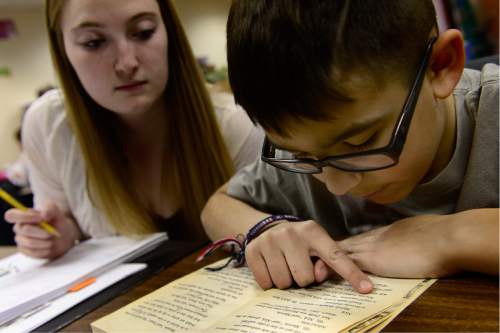This is an archived article that was published on sltrib.com in 2016, and information in the article may be outdated. It is provided only for personal research purposes and may not be reprinted.
As Utah lawmakers are asking for research into why 2 in 5 public-school teachers leave the profession within five years, the state school board is trying to put people — not necessarily teachers — at the front of classrooms as soon as possible.
The board passed a new policy Friday that allows schools to hire individuals without teaching licenses or experience. Applicants must have a bachelor's degree in any field, pass an ethics exam, prove they are proficient in subject areas by taking a test and pass a background check.
After being hired, they'd be mentored and supervised by a "master teacher" at the school for three years.
State Rep. Carol Spackman Moss, D-Salt Lake City, said the relaxed requirements are a shortsighted fix to a larger problem. Teachers, she said, need expertise in managing classrooms and breaking subjects into manageable chunks.
"It's a science and an art," Spackman Moss said. The speedier route, she maintains, is "not the answer."
But some board members said the adjustment is necessary.
The new policy has entered its public-comment phase. Barring a request for a hearing, it goes into effect Aug. 7.
Meanwhile, the legislative Education Interim Committee on Tuesday asked the University of Utah Education and Policy Center to delve deeper into why teachers are dropping out.
A state Office of Education analysis of data from 2011 to 2016 shows that Utah's rate of teacher attrition mirrors the national trend. But when the time frame was narrowed to one year — 2011-2012 — the Beehive State lost instructors at about 15.5 percent, which is twice the national average.
The Utah Board of Education said it needs help from the outside researchers to find out what's driving the attrition.
"We really need some investment in localized research on Utah," Travis Rawlings, a licensing coordinator with the state office, told lawmakers at Salt Lake Community College on Tuesday.
A team of researchers at the U. center has already started reviewing how Utah's lower-than-average teacher compensation and its demographics — with many starting families young — have affected the number.
"There are some unique cultural demographics" in Utah that could skew the state's numbers, noted Rep. LaVar Christensen, R-Draper.
But that cultural trend has long been at play, noted Andrea Rorrer, director of the U.'s Education Policy Center, and the numbers are getting worse. Her team will try to focus on "understanding what's changed and what's different."
Utah's colleges also produce fewer teachers, with enrollment and degrees in the teaching field dropping in the past decade.
The shortfall comes as Utah's public school enrollment has ticked up about 10 percent in the past five years, to more than 640,000 in 2016.
Initial surveys with school districts have revealed that half of Utah schools still had teaching positions open on the first day of school. And over 90 percent of employees who participated in the analysis said they felt the pool of teachers was shrinking.
Some said the loss was "drastic," and other said it was "immeasurable," said Allison Nicholson, a research associate with the center.
The team conducting the study hopes to complete its analysis by the end of the calendar year.



